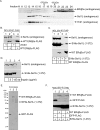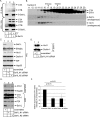The ERdj5-Sel1L complex facilitates cholera toxin retrotranslocation
- PMID: 23363602
- PMCID: PMC3596249
- DOI: 10.1091/mbc.E12-07-0522
The ERdj5-Sel1L complex facilitates cholera toxin retrotranslocation
Abstract
Cholera toxin (CT) traffics from the host cell surface to the endoplasmic reticulum (ER), where the toxin's catalytic CTA1 subunit retrotranslocates to the cytosol to induce toxicity. In the ER, CT is captured by the E3 ubiquitin ligase Hrd1 via an undefined mechanism to prepare for retrotranslocation. Using loss-of-function and gain-of-function approaches, we demonstrate that the ER-resident factor ERdj5 promotes CTA1 retrotranslocation, in part, via its J domain. This Hsp70 cochaperone regulates binding between CTA and the ER Hsp70 BiP, a chaperone previously implicated in toxin retrotranslocation. Importantly, ERdj5 interacts with the Hrd1 adaptor Sel1L directly through Sel1L's N-terminal lumenal domain, thereby linking ERdj5 to the Hrd1 complex. Sel1L itself also binds CTA and facilitates toxin retrotranslocation. By contrast, EDEM1 and OS-9, two established Sel1L binding partners, do not play significant roles in CTA1 retrotranslocation. Our results thus identify two ER factors that promote ER-to-cytosol transport of CTA1. They also indicate that ERdj5, by binding to Sel1L, triggers BiP-toxin interaction proximal to the Hrd1 complex. We postulate this scenario enables the Hrd1-associated retrotranslocation machinery to capture the toxin efficiently once the toxin is released from BiP.
Figures






Similar articles
-
ERdj5 in Innate Immune Cells Is a Crucial Factor for the Mucosal Adjuvanticity of Cholera Toxin.Front Immunol. 2019 Jun 4;10:1249. doi: 10.3389/fimmu.2019.01249. eCollection 2019. Front Immunol. 2019. PMID: 31275300 Free PMC article.
-
The nucleotide exchange factors Grp170 and Sil1 induce cholera toxin release from BiP to enable retrotranslocation.Mol Biol Cell. 2015 Jun 15;26(12):2181-9. doi: 10.1091/mbc.E15-01-0014. Epub 2015 Apr 15. Mol Biol Cell. 2015. PMID: 25877869 Free PMC article.
-
The E3 ubiquitin ligases Hrd1 and gp78 bind to and promote cholera toxin retro-translocation.Mol Biol Cell. 2010 Jan 1;21(1):140-51. doi: 10.1091/mbc.e09-07-0586. Epub 2009 Oct 28. Mol Biol Cell. 2010. PMID: 19864457 Free PMC article.
-
Co-chaperones of the mammalian endoplasmic reticulum.Subcell Biochem. 2015;78:179-200. doi: 10.1007/978-3-319-11731-7_9. Subcell Biochem. 2015. PMID: 25487022 Review.
-
Cholera toxin: an intracellular journey into the cytosol by way of the endoplasmic reticulum.Toxins (Basel). 2010 Mar;2(3):310-25. doi: 10.3390/toxins2030310. Epub 2010 Mar 5. Toxins (Basel). 2010. PMID: 22069586 Free PMC article. Review.
Cited by
-
Co-chaperone Specificity in Gating of the Polypeptide Conducting Channel in the Membrane of the Human Endoplasmic Reticulum.J Biol Chem. 2015 Jul 24;290(30):18621-35. doi: 10.1074/jbc.M115.636639. Epub 2015 Jun 17. J Biol Chem. 2015. PMID: 26085089 Free PMC article.
-
Mechanisms of substrate processing during ER-associated protein degradation.Nat Rev Mol Cell Biol. 2023 Nov;24(11):777-796. doi: 10.1038/s41580-023-00633-8. Epub 2023 Aug 1. Nat Rev Mol Cell Biol. 2023. PMID: 37528230 Review.
-
A deubiquitinase negatively regulates retro-translocation of nonubiquitinated substrates.Mol Biol Cell. 2013 Nov;24(22):3545-56. doi: 10.1091/mbc.E13-06-0332. Epub 2013 Sep 25. Mol Biol Cell. 2013. PMID: 24068323 Free PMC article.
-
ERdj5 in Innate Immune Cells Is a Crucial Factor for the Mucosal Adjuvanticity of Cholera Toxin.Front Immunol. 2019 Jun 4;10:1249. doi: 10.3389/fimmu.2019.01249. eCollection 2019. Front Immunol. 2019. PMID: 31275300 Free PMC article.
-
Toxin instability and its role in toxin translocation from the endoplasmic reticulum to the cytosol.Biomolecules. 2013 Dec 10;3(4):997-1029. doi: 10.3390/biom3040997. Biomolecules. 2013. PMID: 24970201 Free PMC article.
References
-
- Abujarour RJ, Dalal S, Hanson PI, Draper RK. p97 is in a complex with cholera toxin and influences the transport of cholera toxin and related toxins to the cytoplasm. J Biol Chem. 2005;280:15865–15871. - PubMed
Publication types
MeSH terms
Substances
Grants and funding
LinkOut - more resources
Full Text Sources
Other Literature Sources

